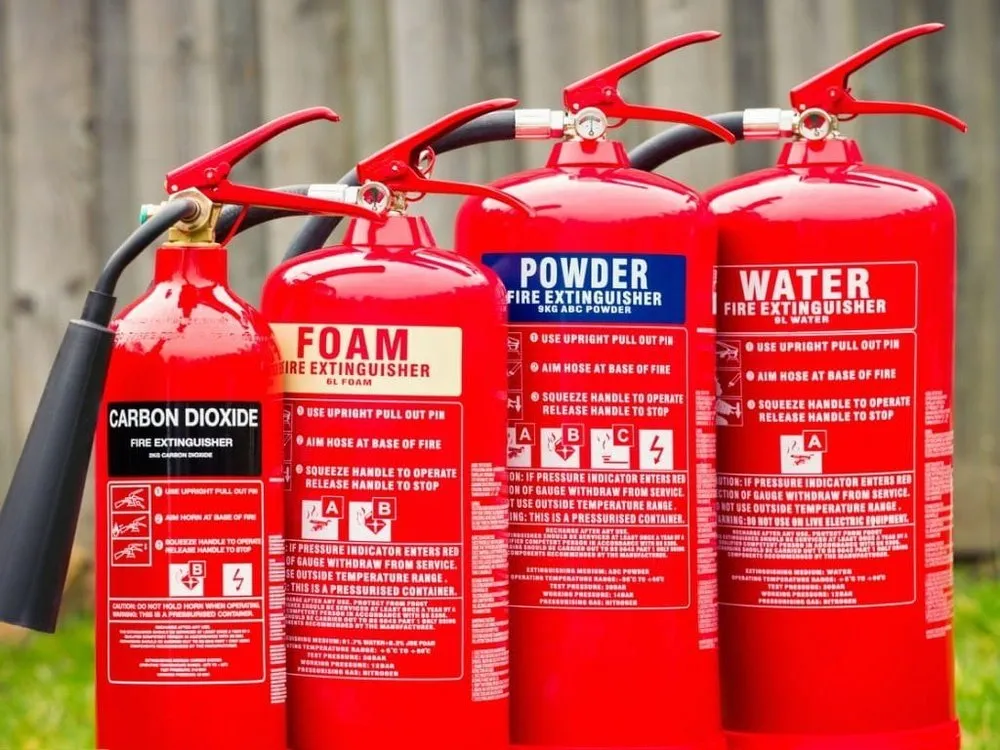
In HFC INDIA PVT LTD a fire extinguisher is a portable active fire
protection tool used to put out or control small fires, frequently in
emergencies. It is typically packed with a dry or wet chemical. It is
not meant to be used on a fire that is out of control, such as one that
has spread to the ceiling, or on any other situation that calls for a
fire brigade’s equipment, personnel, resources, and/or skill. A fire
extinguisher typically consists of a hand-held cylindrical pressure
vessel that can be discharged with a chemical to put out a fire.
Although less common, fire extinguishers can also be made using
pressure containers that are not cylindrical.
Business owners tend to think of fire extinguishers as constants — they’re always nearby, ready and waiting if a fire breaks out. But the truth is that fire extinguishers often are not prepared because they haven’t been adequately maintained. There are countless instances of employees attempting to fight an incipient-stage fire with a portable extinguisher only to discover too late that the fire extinguisher is not charged — even if it has never been used before.
Business owners need to understand the importance of fire extinguisher recharging. This process is an essential aspect of fire extinguisher service and maintenance and cannot be ignored.


An undercharged, expired, or depressurized fire extinguisher can endanger your personnel and property. Commercial and industrial facilities need their fire extinguishers recharged by trained fire protection professionals to meet state codes, OSHA requirements, and insurance company recommendations.
Fire protection companies have the tools, training, and knowledge to ensure fire extinguishers are in peak working condition and appropriately refilled with the correct extinguishing agent. A qualified fire protection service provider will have deep expertise recharging all types of fire extinguishers, including:
Fire extinguishers must be recharged directly after use to ensure enough pressure and suppressant liquid are stored and ready to extinguish a fire. Below are several instances where fire extinguisher recharging needs to occur.
Immediately after each use – Fire extinguishers need to be recharged immediately after each use. Even if the extinguishing agent inside was not completely discharged, the extinguisher still needs to be serviced to ensure it’s ready for its subsequent use. A minimal discharge will typically result in leakage and an eventual total loss of pressure required for proper operation.
Periodically throughout their life – Fire extinguishers need to be recharged regularly throughout their life. The manufacturer’s service guidelines and the NFPA 10 standard for portable fire extinguishers require periodic internal examination and recharging even if they haven’t been used. For the most commonly used stored pressure dry chemical fire extinguishers, this internal examination and recharging are required at six and twelve years from the date of manufacture noted on the extinguisher.
Signs of apparent damage, corrosion, or nozzle blockage – Fire extinguishers need to be inspected or recharged due to deterioration or other environmental factors that may result in them becoming depressurized.

Business owners should perform a quick fire extinguisher inspection at least once per month, and one of the most important factors to check during this inspection is the pressure gauge. The gauge will tell you whether the unit is undercharged, overcharged, or within the operational zone. You want the needle to point within the green area for optimal use. If the pressure gauge is in the “Recharge” position or is reading in the “Over Pressurized Range,” the best thing is to bring it to a fire protection technician for service.
Here is what you can expect when your fire extinguisher is recharged. Below is not a guide for recharging a fire extinguisher but an overview so that you can understand the process.
The extinguisher is depressurized completely, and the agent is removed from the cylinder.
The discharge valve is removed from the cylinder.
The siphon tube is removed from the valve, and the valve stem and spring are removed.
The technician cleans the valve, replaces the valve neck o-ring, and visually inspects the unit internally and externally for signs of damage.
Once cleaned, the valve is reassembled with a new valve stem installed to ensure proper seating and avoid future pressure loss.
The extinguishing agent (water, carbon dioxide, dry chemical, etc.) is refilled by weight to the appropriate amount for the size of the unit and as specified in the recharging instructions for that unit.
As noted on the recharging instructions, the unit is re-pressurized with the appropriate pressurizing gas.
The technician completes a Leak Test to check for signs of leakage and reinstalls the discharge nozzle or hose.
The extinguisher is weighed again to confirm that the total weight is within the allowable tolerance indicated by the manufacturer.
A new tamper seal is installed on the safety pin, and a new recharge tag is attached to the unit, with each tag indicating the unit’s total weight and the identity of the technician completing the work.
Stay Protected and Prepared with Fire Extinguisher Recharging Services
One of the simplest ways to help protect your business from incipient-stage fires is to partner with an experienced fire protection company to conduct thorough maintenance procedures such as fire extinguisher recharging.
While a visual inspection may uncover something wrong with a fire extinguisher, fire prevention professionals should only conduct thorough inspections and maintenance procedures. Whether immediately after each use, periodically throughout their life, or when depressurization occurs, our trained technicians are available 24/7 to recharge your fire extinguishers to ensure regulatory compliance and functionality.
When it’s time for service, technicians will arrive promptly at your location — eliminating the need to schedule an appointment. Highly trained fire extinguisher technicians will inspect safety devices to ensure it is safe to recharge. Then, they perform the refilling process for you at minimal time and cost. If the fire extinguisher is damaged or unsafe to recharge, fire protection professionals can recommend an appropriate replacement.

Our qualified technicians are ready 24/7 to recharge your fire extinguishers to ensure regulatory compliance and operation, whether immediately following each use, on a regular basis throughout their life, or when depressurization occurs.
